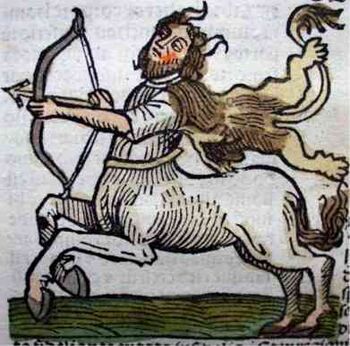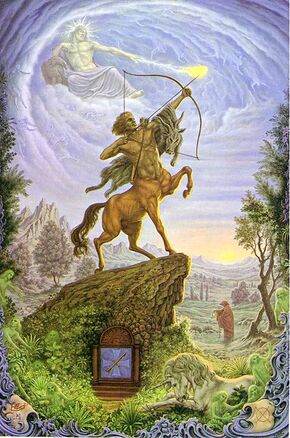Sagittarius

Symbol: 
Ruling Planet: Jupiter
Tarot Key: The Temperance
Sun in Sagittarius: from around the 22. November to the 21. December.
Time of Year: Darkness, bare branches, the end of the lifecycle
Cultural: Harbinger of new life, Lights of Advent, Lucy, bringer of light, Barbara branches, the buds in winter, Saint Nicholas / Santa Claus
Physical Body: Hips and thighs, Liver
Star constellation: Sagittarius
Mythology of the constellation
Liz Greene[2]: Sagittarius, the last of the fire signs, coincides with the increasing darkness of early winter. As the landscape becomes starker and the year moves toward its end, external activity is curtailed and the world of the imagination comes alive.
The sign of Sagittarius is linked with the mythic centaur, whose origins go back to Babylon, and who is found in the figure of Chiron among the pantheon of the planetary gods. The centaur's duality is reflected in the contradictory nature of the sign, for it possesses both the raw vigor and power of the horse and the aspiring vision of the human spirit.
The name Sagittarius comes from the Latin word for arrow, sagitta. The centaur's arrow, flying toward some distant goal, is an image of his quest for greater understanding, not only of his own mythic wound, but also of a universe in which the gods are just, though suffering and death are still part of the condition of all living things.
Half beast and half divine, the centaur embodies the paradox of the human animal whose powerful and potentially destructive instincts are guided by hopes, ideals and a world-view which recognizes the sanctity of life.
In myth, centaurs could be rowdy and uncontrollable, especially when drunk. Yet the arrow of Sagittarius in the heavens is aimed directly at the heart of Scorpio, thus suggesting that the centaur's enlightened vision can illuminate those darker human passions that lead us into blind destructiveness.
Sagittarius is usually seen as being related to the centaurs, creatures with a human upper-body and the lower-body of a horse. In mythology the centaurs stand for the ambivalence between the unconscious world of animal instincts and the conscious, intellectual and cultural world of humans. This made them unpredictable. Some of them, in particular Chiron, were highly cultivated and sought spiritual enlightenment. Chiron was both a teacher and a student who continually sought to increase his knowledge. Others were instinctive, quarrelsome and enjoyed drinking and raping. In their wild attacks on Hercules they usually came off worse.
According to another version, the constellation is related to the Satyre Krotos, a human-like creature with the tail of a horse and the horns and legs of a ram who invented the bow. He grew up among the muses and was the son of their wet nurse. Similarly ambivalent characteristics were attributed to the Satyrs as were attributed to the Centaurs. They could be civilised and responsible, but also wild and uninhibited.
Interpretation
Sagittarius is the ninth sign of the zodiac. It is concerned with integrating knowledge into a greater whole. Sagittarius gazes into the distance - it is orientated towards the future and strives to discover the meaning in everything. It perceives the world in a holistic manner.
Individuals with an emphasis of this sign are always trying to broaden their horizons, whether by travelling and getting to know foreign cultures or immersing themselves in philosophy. They want to form their own picture of the world and collect knowledge to this end. However, their aim is not to collect as many facts as possible but to understand their meaning and how they come together to form a more encompassing whole. This is the reason why they are often interested in religion and spirituality. Faith and experience is more important to them than knowledge. Their optimism can sometimes cause them to forget that life also has some more unpleasant aspects and that lows follow highs. The optimism of Sagittarian individuals can be infectious although their optimism is sometimes followed by periods of deep depression without them quite knowing why.
Sagittarian individuals need convictions. And they are very good at carrying others along on their wave of enthusiasm. However, this can sometimes turn negative: when belief turns into fanaticism and the need to convert others or when self-righteousness takes over.
Axes and planets in the sign of Sagittarius take on Sagittarian characteristics such as optimism, greatness and farsightedness. Sagittarius shares the quality of versatility with its opposite sign Gemini. But whereas for Gemini this can be an end in itself, for Sagittarius it is a means to an end: namely to achieve a greater understanding. Sagittarius, together with the other two fire signs Aries and Leo, has the ability to actively change the course of life. Aries gives the impulse, Leo is the centre of attention and Sagittarius passes on the idea. Sagittarius can learn valuable lessons from the signs that are in archetypal square to it: from Virgo the attention to detail and from Pisces the trust in the flow of life.
Mercury is in detriment in Sagittarius.
See also
Weblinks
- Sagittarius the Archer (Deborah Houlding, Skyscript)
- The Zodiac Suite: "Sagittarius" by Rebecca Tripp (youTube - Video)
- Sound of zodiac - Sagittarius (youTube)
